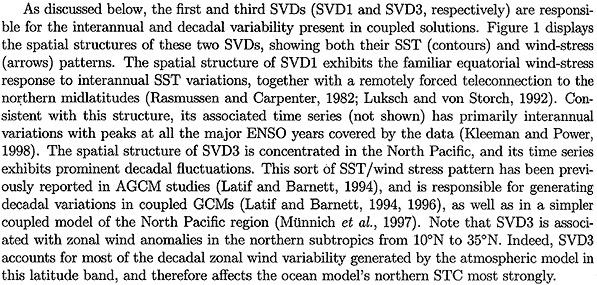
3 RESULTS
Figure 2 illustrates the time dependence of our main-run solution, displaying time series of SST anomalies in the NINO3.5 region (180。?-120。?, 5。?-5。?) and zonal-wind-stress anomalies in the northern subtropics (135。?-120。?, 20。?-25。?). The SST curve exhibits a decadally modulated interannual oscillation with a period of about 4 years, whereas the wind-stress response is predominantly a decadal signal with a period of 12 years. The clear impression is that the decadal modulation of equatorial SST coincides with the decadal variation in the subtropical wind stress.
Figure 3a illustrates the spatial nature of the decadal SST fluctuations.The plot is obtained by regressing the subtropical wind-stress index in Figure 2 against the SST anomaly field. For comparison, Figure 3b shows the pattern of observed SST decadal variability determined by the principal oscillation pattern (POP) statistical technique (Latif et al., 1997), a pattern that was particularly apparent during the early half of the current decade (Kleeman et al., 1997). The solution reproduces the POP structure reasonably well, except that its equatorial signal is stronger than it is in Figure 3b. A significant equatorial response, however, is known to be associated with observed decadal variability: For example, the positive phase of the decadal cycle (such as the 1960s and 1980s) coincided with a preponderance of warm events, while the converse was true for the negative phase (the 1950s and the 1970s). It may be, then, that this model/data difference is an artifact of the POP analysis, rather than being indicative of a model deficiency.

